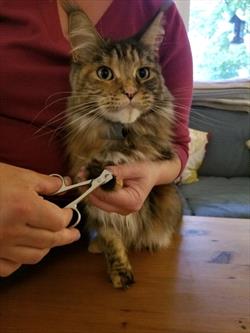Katharine Schwarz, RVT, KPA CTP; Sarah Nugen, Class of 2023; Sandra Robbins BS, CVT, VTS (Anesthesia & Analgesia), CPDT-KSA, KPA-CTP;
Allowing cat to sit up during nail trim

Photo courtesy of Katharine Schwarz, RVT, KPA CTP
Many cat owners never learned to trim their kitten’s nails and struggle with nail trims for their adult cat. To prevent scratches to people and furniture, as well as to decrease the potential of too long nails causing pain, difficulty walking, and other medical issues your cat’s nails will need to be trimmed from time to time. To make trimming your cat’s nails easy for you and acceptable for your cat will take time, patience, and rewards.
There are several low stress handling methods that can be used to make it easier for you to trim nails, such as a towel wrap or allowing the cat to sit comfortably in a lap. Distractions such as toys or food can also be helpful during trimming.
Technique for Adult Cats
It is not too late to begin training an adult cat to get their nails trimmed. You can still make this experience a positive one. Similar to training a kitten, this process takes time, patience, and rewards. Nail trims should be done in the position that is best for your cat, whether they are sitting, standing, or lying down. Choose a location where your cat is most comfortable such as on your lap, or on their favorite perch.
Your cat will not have the patience for all their nails to be trimmed during the first few training sessions, so start this process when they are not urgently needing a nail trim. Each training session should be kept to less than two minutes. Frequent, short training sessions are better than long sessions.
- When your cat is in their comfortable place, practice touching the top of their foot and then feeding a treat. Alternatively, you could place a bowl of wet food or treats in front of them during this process. Practice this several times, giving your cat a treat after each foot touch. Each foot should be touched separately.
- If your cat displays signs of stress or gets up to leave, stop the training and just play. The next session, remember to stay under your cat’s threshold of stress to keep this a positive experience.
- Practice handling each foot lightly, then feeding a treat. You may only be able to touch the foot but not pick it up the first few times.
- Gradually, practice until you can handle each of your cat’s feet and toes. Isolate each toe individually and practice inspecting the area where you will trim the nail. Remember to treat after every nail examination.
Monitor cat closely during nail trim for discomfort

Monitor closely for signs your cat is uncomfortable. This cat initially acted uncomfortable but seems to have a better time once treats were used. Photo courtesy of Katharine Schwarz, RVT, KPA CTP.
- When your cat is comfortable allowing you to isolate a toenail, try trimming one nail. Treat immediately after trimming it and then stop the session. Engage your cat in something rewarding like play or a petting session. If your cat seems stressed or nervous about the nail trimmers, you may need to work on desensitizing your cat to them.
- Eventually, your cat will tolerate having multiple nails trimmed during the same session, but it will take time and practice to get there.